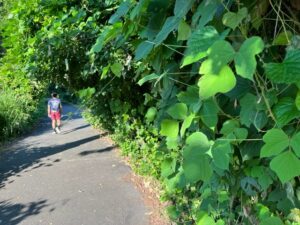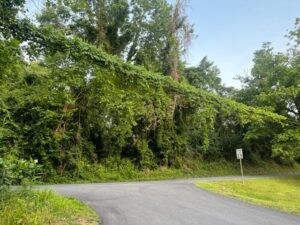I’ve walked this way many times – the route down to the river trail. I walk further downhill along narrow sidewalks, along a utility substation with buzzing machinery, down a gravel road. For some reason, it feels different on this day in an oddly menacing way. I spot a utility pole and can barely see the pole for the vine that is using it as a trellis. I quicken my pace, not knowing exactly why. As I draw closer, I notice that the vine – I recognize it now as kudzu – is not only creeping up the pole but also laterally along the ground, and has in fact covered an area several hundred feet in diameter.
Now I am jogging and breaking into an all-out run with sweat running down my forehead and stinging my eyes. I’m breathing hard. But the effort is not enough. As I pass the pole, I feel something ropey against one ankle and then the other. I look down to see a kudzu tendril twining around my ankles and reaching for my thighs. The vine hinders my forward progress to a pathetic slog and has now reached my torso. I stumble forward and hold my arms out as I pitch towards the ground. I scream out.
And then I wake up.
Kudzu does not move THAT fast, but. . .
I know I live in the Piedmont Upland Eco-region and Plant Hardiness Zone 7b, but this summer I feel like it should be called the “Vine Zone.”
Left unattended — without the fitful yanking, tugging, and pulling of some crazed humans — my urban landscape would fall prey to the vines. Is it just me, or does the phenomenon seem more pronounced in recent years?
The bittersweet is mounting my backyard fence from my neighbor’s property. My neighbor, Pete, being generally fastidious about his yard, would never let this happen. But Pete is 99 years old and has been in a rehab facility for the duration of the growing season and has not be able to tend his shrubs for a number of years. The bittersweet mocks Pete as it reaches for my Redbud.

Good fences make good neighbors says Robert Frost, but they also make good structures for invasive vines.
Then there is the garden. The bindweed (bindweed – perhaps the subject of my next vegetative nightmare) is running amok, coursing over the peonies seeking the irresistible vertical structure of the tomato cages. The Virginia creeper is living up to its name in the Arborvitae. And, of course, down along the river trail, the killer kudzu is battling with the porcelain berry for cruel dominance.
Mid-summer is not my prime season, energetically speaking. I tend towards lethargy and a bit of ennui. The vines are OK with this and even capitalize on it, as I am more apt to sneer in their direction than mount a frontal assault.
But I am mustering my forces, which for my small patch of earth involves yanking, unwinding, clipping, and pulling rather than herbicides. But what would I do if it was the entire back-40? Well, it really is when I consider the greater neighborhood beyond my fence line.
Knowing that all things are interconnected, I am thinking the relative success of the vines has to do with the overall issue of invasive species, certainly the climate, the city soils I dwell upon, and maybe even the cat bird squawking away incessantly on the top rail of the fence and casting around whatever intestinal seed load it may be carrying.
Whatever the cause, I am left with my current course of action — a haiku:
Reach, probe, climb, and twist
The vines they are a twining
Ire – a small defense
David J. Hirschman, [email protected]
Postscript: I wrote this post last week. Over the weekend and after a heavy rain, Garnett and I did wrestle with some of the vines. After a sweaty couple of hours, I still cannot say that our efforts were any more effective than the haiku — ah, the power of poetry.



